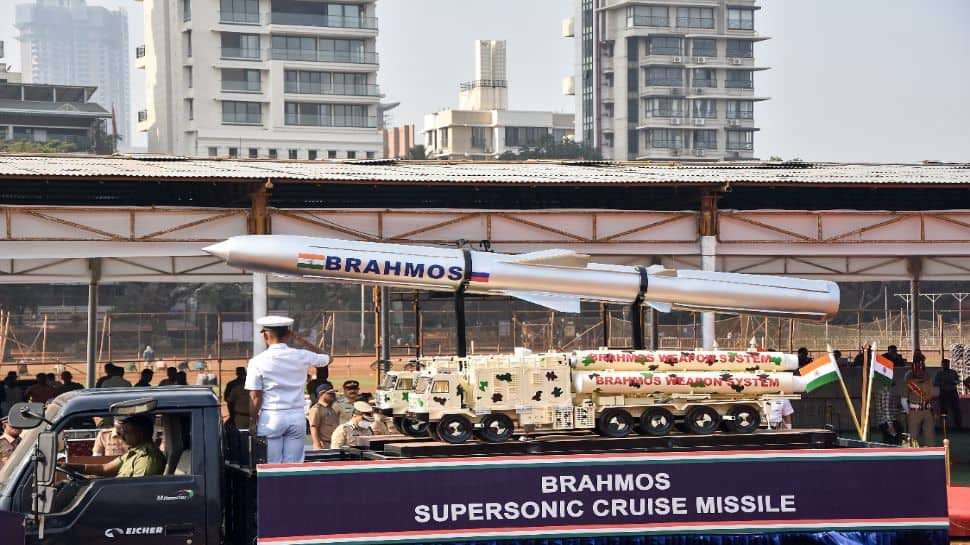New Delhi: India, in a historic first, deployed its BrahMos supersonic cruise missile in active combat as part of a coordinated but measured precision strike against key Pakistani military infrastructure early on May 10. Known for its speed, accuracy and versatility, the use of the BrahMos highlighted India’s ability to project overwhelming firepower with technological superiority while maintaining strategic restraint. Conducted in response to a series of Pakistani provocations, the strikes targeted important air bases and radar sites deep within enemy territory, crippling Pakistan’s forward-operating capabilities.
India’s air offensive, according to sources, relied on an array of advanced weaponry, including HAMMER precision-guided munitions, SCALP cruise missiles and loitering munitions. But it was the combat debut of the Indo-Russian BrahMos missile that marked a turning point in the operational doctrine of the Indian military. With pinpoint accuracy and rapid execution, the strikes systematically dismantled Pakistan’s ability to coordinate air operations or launch credible retaliatory strikes.
The chosen targets, airbases at Rafiqui (Shorkot), Murid (Chakwal), Nur Khan (Chaklala), Rahim Yar Khan, Sukkur, Chunian (Kasur), Skardu, Bholari, Jacobabad and Sargodha as well as radar stations at Pasrur and Sialkot, were not only vital military assets but symbols of Pakistan’s strategic depth. The attack effectively blinded Pakistan’s air defense grid and fractured its command-and-control network at a critical moment.
The Indian military’s choice of targets reflected strategic precision. Nur Khan Airbase, located near Islamabad, was hit to sever Pakistan’s air mobility command, crippling logistical coordination. Home to frontline PAF fighter squadrons, Rafiqui was struck at the height of its operational alertness. Murid, which houses Pakistan’s unmanned aerial vehicles and combat drones, was also a primary objective. Meanwhile, Skardu and Bholari, vital for northern and southern air operations, were neutralised to limit Pakistan’s geographic reach and rapid deployment capability.
Notably, officials made it clear that their objective was not escalation but deterrence. Speaking at a special joint press briefing by the Ministry of Defence and the Ministry of External Affairs, Colonel Sofiya Qureshi and Wing Commander Vyomika Singh, flanked by Foreign Secretary Vikram Misri, emphasised India’s intent to contain the conflict.
“Actions have been effectively countered and responded to appropriately,” said Colonel Qureshi, adding, “The Indian armed forces reiterate their commitment to non-escalation—provided it is reciprocated.”
The counteroffensive came after Pakistan launched over 26 air intrusion attempts across a wide front stretching from Srinagar to Nalia, employing drones, loitering munitions and long-range weapons. These attempts were successfully intercepted, but not before Pakistan’s attacks caused limited damage at Indian Air Force stations in Udhampur, Pathankot, Adampur, and Bhuj.
Wing Commander Singh also condemned Pakistani missile attacks post 1:40 a.m., describing them as a “deplorable and cowardly act” targeting medical and educational facilities.
Indian officials also rejected Pakistan’s claims of having destroyed several Indian air installations as falsehoods meant to fuel a misinformation campaign. Time-stamped images of Adampur, Sirsa, and the BrahMos base at Nagrota were shared with the press to refute the allegations.
The operation was not just a military maneuver; it was a calculated assertion of India’s strategic doctrine in the face of nuclear posturing and asymmetric threats. By relying on high-precision, low-collateral weaponry and maintaining firm control over escalation, New Delhi demonstrated its ability to defend national interests without falling into the trap of uncontrolled retaliation.
According to The New York Times, the strikes, particularly the one on Nur Khan Airbase, which is located near Pakistan’s Strategic Plans Division that oversees the country’s nuclear arsenal, caused immediate concern in Washington. Alarmed by the proximity of the strike to critical nuclear infrastructure, the United States swiftly intervened to mediate and defuse the situation.
US Secretary of State Marco Rubio reached out directly to Pakistan’s Army Chief General Asim Munir, asking him to de-escalate the situation. Intelligence assessments suggested that Munir was acting independently of Pakistan’s civilian leadership. It heightened the urgency of US diplomatic efforts.
Simultaneously, US Vice President JD Vance called Indian Prime Minister Narendra Modi, cautioning him of a high likelihood of rapid and dramatic escalation. He encourage the prime minister to open direct lines of communication with Islamabad.
Behind the scenes, a high-stakes backchannel operation was activated involving several US agencies working in concert to ensure both sides received parallel messages aimed at immediate de-escalation.
US President Donald Trump, in a public statement following the ceasefire, praised both India and Pakistan for their restraint and leadership. “Millions of innocent people could have died… Your legacy is greatly enhanced by your brave actions. I am proud the USA helped achieve this historic and heroic decision.”
India’s calibrated military posture has redrawn the contours of South Asian deterrence: smart, swift and strategically surgical.
#BrahMos #Blitz #Leaves #Pakistan #Reeling #Strikes #Forced #Ceasefire
BrahMos, BrahMos missile, India Pakistan conflict, India airstrike, Pakistan air bases, precision strike, BrahMos debut, Indian Air Force, Indo-Russian missile, Nur Khan airbase, US intervention India Pakistan, JD Vance Modi call, Marco Rubio Pakistan,BrahMos Missile, India-Pakistan conflict, Precision Strikes, ceasefire, South Asia Tensions, US diplomacy, Nuclear deterrence, Indian Air Force, Pakistan military, Strategic Strikes, Marco Rubio, JD Vance, Donald Trump, Nur Khan Airbase, Operation Sindoor
latest news today, news today, breaking news, latest news today, english news, internet news, top news, oxbig, oxbig news, oxbig news network, oxbig news today, news by oxbig, oxbig media, oxbig network, oxbig news media
HINDI NEWS
News Source


